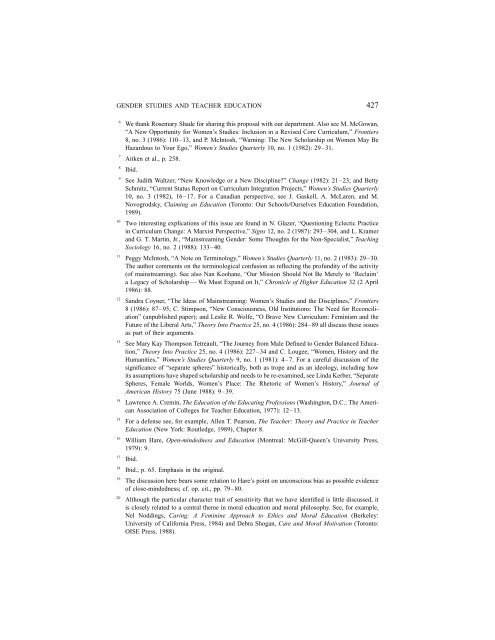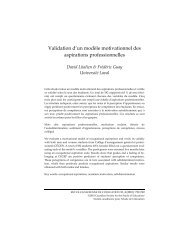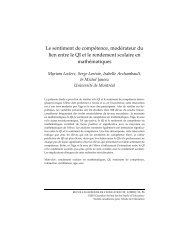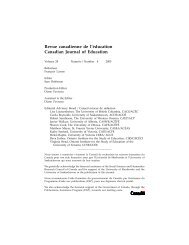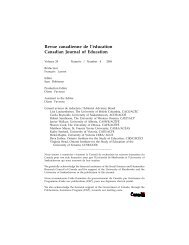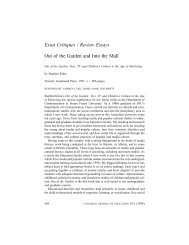Mireille Falardeau et Michel Loranger Le choix de stratégies ... - CSSE
Mireille Falardeau et Michel Loranger Le choix de stratégies ... - CSSE
Mireille Falardeau et Michel Loranger Le choix de stratégies ... - CSSE
You also want an ePaper? Increase the reach of your titles
YUMPU automatically turns print PDFs into web optimized ePapers that Google loves.
GENDER STUDIES AND TEACHER EDUCATION 427<br />
6 We thank Rosemary Sha<strong>de</strong> for sharing this proposal with our <strong>de</strong>partment. Also see M. McGowan,<br />
“A New Opportunity for Women’s Studies: Inclusion in a Revised Core Curriculum,” Frontiers<br />
8, no. 3 (1986): 110–13, and P. McIntosh, “Warning: The New Scholarship on Women May Be<br />
Hazardous to Your Ego,” Women’s Studies Quarterly 10, no. 1 (1982): 29–31.<br />
7 Aitken <strong>et</strong> al., p. 258.<br />
8<br />
Ibid.<br />
9<br />
See Judith Waltzer, “New Knowledge or a New Discipline?” Change (1982): 21–23; and B<strong>et</strong>ty<br />
Schmitz, “Current Status Report on Curriculum Integration Projects,” Women’s Studies Quarterly<br />
10, no. 3 (1982), 16–17. For a Canadian perspective, see J. Gaskell, A. McLaren, and M.<br />
Novogrodsky, Claiming an Education (Toronto: Our Schools/Ourselves Education Foundation,<br />
1989).<br />
10<br />
Two interesting explications of this issue are found in N. Glazer, “Questioning Eclectic Practice<br />
in Curriculum Change: A Marxist Perspective,” Signs 12, no. 2 (1987): 293–304, and L. Kramer<br />
and G. T. Martin, Jr., “Mainstreaming Gen<strong>de</strong>r: Some Thoughts for the Non-Specialist,” Teaching<br />
Sociology 16, no. 2 (1988): 133–40.<br />
11<br />
Peggy McIntosh, “A Note on Terminology,” Women’s Studies Quarterly 11, no. 2 (1983): 29–30.<br />
The author comments on the terminological confusion as reflecting the profundity of the activity<br />
(of mainstreaming). See also Nan Koohane, “Our Mission Should Not Be Merely to ‘Reclaim’<br />
a <strong>Le</strong>gacy of Scholarship — We Must Expand on It,” Chronicle of Higher Education 32 (2 April<br />
1986): 88.<br />
12<br />
Sandra Coyner, “The I<strong>de</strong>as of Mainstreaming: Women’s Studies and the Disciplines,” Frontiers<br />
8 (1986): 87–95; C. Stimpson, “New Consciousness, Old Institutions: The Need for Reconciliation”<br />
(unpublished paper); and <strong>Le</strong>slie R. Wolfe, “O Brave New Curriculum: Feminism and the<br />
Future of the Liberal Arts,” Theory Into Practice 25, no. 4 (1986): 284–89 all discuss these issues<br />
as part of their arguments.<br />
13<br />
See Mary Kay Thompson T<strong>et</strong>reault, “The Journey from Male Defined to Gen<strong>de</strong>r Balanced Education,”<br />
Theory Into Practice 25, no. 4 (1986): 227–34 and C. Lougee, “Women, History and the<br />
Humanities,” Women’s Studies Quarterly 9, no. 1 (1981): 4–7. For a careful discussion of the<br />
significance of “separate spheres” historically, both as trope and as an i<strong>de</strong>ology, including how<br />
its assumptions have shaped scholarship and needs to be re-examined, see Linda Kerber, “Separate<br />
Spheres, Female Worlds, Women’s Place: The Rh<strong>et</strong>oric of Women’s History,” Journal of<br />
American History 75 (June 1988): 9–39.<br />
14<br />
Lawrence A. Cremin, The Education of the Educating Professions (Washington, D.C.: The American<br />
Association of Colleges for Teacher Education, 1977): 12–13.<br />
15<br />
For a <strong>de</strong>fense see, for example, Allen T. Pearson, The Teacher: Theory and Practice in Teacher<br />
Education (New York: Routledge, 1989), Chapter 8.<br />
16<br />
William Hare, Open-min<strong>de</strong>dness and Education (Montreal: McGill-Queen’s University Press,<br />
1979): 9.<br />
17<br />
Ibid.<br />
18<br />
Ibid., p. 65. Emphasis in the original.<br />
19<br />
The discussion here bears some relation to Hare’s point on unconscious bias as possible evi<strong>de</strong>nce<br />
of close-min<strong>de</strong>dness; cf. op. cit., pp. 79–80.<br />
20<br />
Although the particular character trait of sensitivity that we have i<strong>de</strong>ntified is little discussed, it<br />
is closely related to a central theme in moral education and moral philosophy. See, for example,<br />
Nel Noddings, Caring: A Feminine Approach to Ethics and Moral Education (Berkeley:<br />
University of California Press, 1984) and Debra Shogan, Care and Moral Motivation (Toronto:<br />
OISE Press, 1988).


